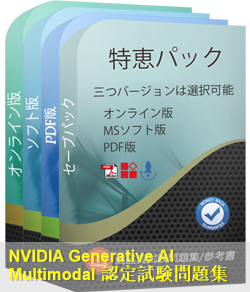NCA-GENM試験の品質と価値
JPNTestのNVIDIA-Certified Associate NCA-GENM模擬試験問題集は、認定された対象分野の専門家と公開された作成者のみを使用して、最高の技術精度標準に沿って作成されています。
JPNTestでNVIDIA NCA-GENM問題集をチョイスする理由
JPNTestは、1週間で完璧に認定試験を準備することができる、忙しい受験者に最適な問題集を提供しております。 NCA-GENMの問題集は、NVIDIAの専門家チームがベンダーの推奨する授業要綱を深く分析して作成されました。弊社のNCA-GENM学習材料を一回のみ使用するだけで、NVIDIA認証試験に合格することができます。
NCA-GENMはNVIDIAの重要な認証であり、あなたの専門スキルを試す認定でもあります。受験者は、試験を通じて自分の能力を証明したいと考えています。 JPNTest NVIDIA Generative AI Multimodal は、NVIDIA-Certified Associateの403の問題と回答を収集して作成しました。NVIDIA Generative AI Multimodalの知識ポイントをカバーし、候補者の能力を強化するように設計されています。 JPNTest NCA-GENM受験問題集を使用すると、NVIDIA Generative AI Multimodalに簡単に合格し、NVIDIA認定を取得して、NVIDIAとしてのキャリアをさらに歩むことができます。
あなたのNCA-GENM試験合格を100%保証
JPNTestテスト問題集を初めて使用したときにNVIDIA-Certified Associate NCA-GENM試験(NVIDIA Generative AI Multimodal)に合格されなかった場合は、購入料金を全額ご返金いたします。
NCA-GENMの迅速なアップデート対応
NCA-GENM試験に変更がございました場合は、現在の試験と一致するよう、瞬時に学習資料を更新することができます。弊社は、お客様に最高、最新のNVIDIA NCA-GENM問題集を提供することに専念しています。なお、ご購入いただいた製品は365日間無料でアップデートされます。
ダウンロード可能なインタラクティブNCA-GENMテストエンジン
NVIDIA-Certified Associateの基礎準備資料問題集には、NVIDIA-Certified Associate NCA-GENM試験を受けるために必要なすべての材料が含まれています。詳細は、正確で論理的なものを作成するために業界の経験を常に使用しているNVIDIA-Certified Associate によって研究と構成されています。
NVIDIA Generative AI Multimodal 認定 NCA-GENM 試験問題:
1. You are using NeMo to fine-tune a large language model for a specific task. You notice that the model is overfitting to the training dat a. Which of the following techniques could you apply to mitigate overfitting in this scenario? (Select all that apply)
A) Decrease the learning rate.
B) Increase the size of the training dataset.
C) Increase the batch size.
D) Add dropout layers to the model architecture.
E) Implement weight decay (L2 regularization).
2. You are working with a large dataset of images for training a generative model. The dataset contains a significant amount of noise and outliers. Which of the following data preprocessing techniques would be MOST effective in mitigating the impact of noise and outliers on the model's performance?
A) Applying a Gaussian blur to all images.
B) Using a robust statistics-based normalization technique (e.g., Z-score normalization with median and interquartile range).
C) Clipping pixel values to a specific range (e.g., [0, 255]).
D) Converting all images to grayscale.
E) Applying histogram equalization to all images.
3. You're building a system that takes a medical image (e.g., X-ray) and a patient's medical history (text) as input, predicting the likelihood of a specific disease. You want to use SHAP (SHapley Additive exPlanations) values to explain the model's predictions. How would you adapt SHAP to handle both image and text inputs effectively?
A) Use a multimodal SHAP implementation that is designed to handle both image and text features simultaneously, considering their interaction.
B) Represent both the image and text as numerical vectors and then apply a standard SHAP explainer.
C) Treat the image and text as separate models and explain each independently.
D) Use DeepExplainer for the image component and a simple linear SHAP explainer for the text.
E) Apply KernelSHAP separately to the image and text, then combine the results.
4. You are working on a generative A1 model that creates descriptions of images. During experimentation, you notice the model consistently generates descriptions that are factually incorrect about objects in the image, despite the image quality being high. For example, it might describe a 'cat' as a 'dog'. What is the MOST critical step to address this issue?
A) Use a more complex model architecture.
B) Increase the training data size with more diverse images.
C) Fine-tune the model using a smaller learning rate.
D) Implement a mechanism to verify the generated descriptions against an external knowledge base or object recognition system.
E) Apply image sharpening filters to the input images.
5. You have a dataset of customer reviews for a Generative A1 service. The dataset contains text reviews, numerical ratings (1-5 stars), and categorical data about the customer's subscription plan (Basic, Premium, Enterprise). You want to build a model to predict the numerical rating based on the text review and subscription plan. Which data analysis and modeling approach would be MOST suitable?
A) Train a deep learning model (e.g., BERT or RoBERTa) on the text reviews, concatenate the output embeddings with the one-hot encoded subscription plan, and use a regression layer to predict the numerical rating.
B) Use topic modeling on the text reviews, then use logistic regression to predict the numerical rating based on the topic distributions and subscription plan.
C) Calculate the average word length of the text reviews and use that as a feature in a linear regression model along with the subscription plan to predict the rating.
D) Perform sentiment analysis on the text reviews, then use linear regression to predict the numerical rating based on the sentiment score and subscription plan (one-hot encoded).
E) Use a decision tree to predict the numerical rating based on the text reviews (using TF-IDF) and subscription plan.
質問と回答:
| 質問 # 1 正解: A、B、D、E | 質問 # 2 正解: B | 質問 # 3 正解: A | 質問 # 4 正解: D | 質問 # 5 正解: A |


 284 お客様のコメント
284 お客様のコメント





